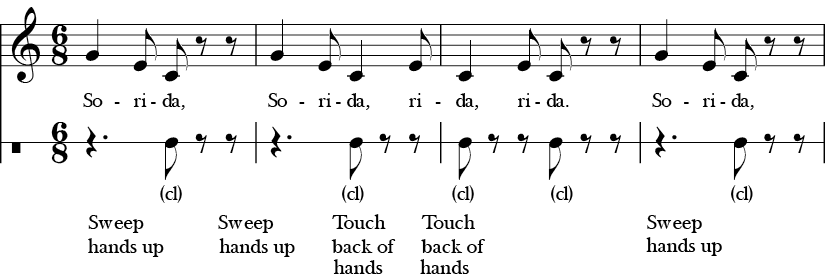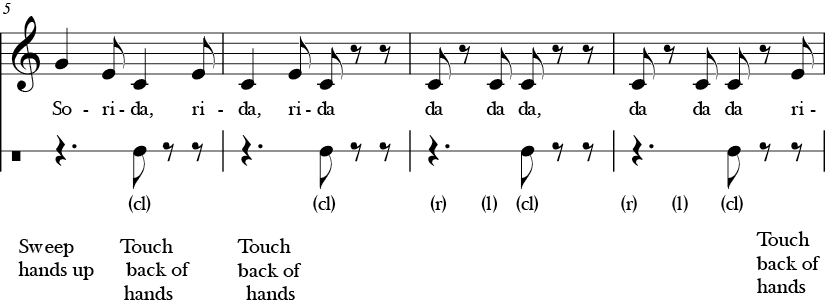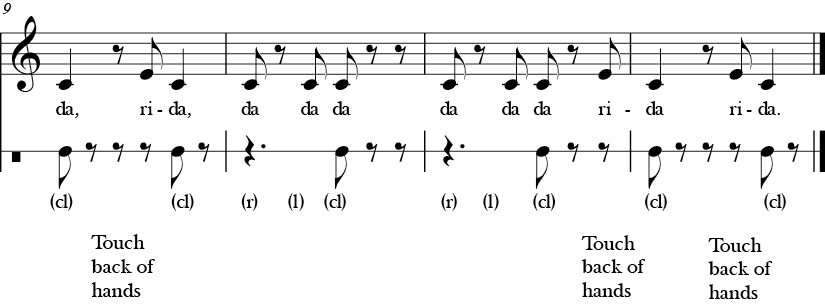Main Body
Chapter 13: Musical Multiculturalism and Diversity
Chapter Summary: As part of 21st century teaching and common core state standards, it is important to “teach to reach”—in other words, organizing your materials and presentation to reach as many children as possible in as many possible ways. We’ve discussed many ways of teaching in this book, and this section concerns teaching multicultural material and teaching to culturally diverse learners. This chapter will look at the history of multiculturalism and diversity education, the field of ethnomusicology, and strategies for teaching using multicultural music aesthetics. It also includes case studies from several different culture areas.
Music, as a diverse human practice, is central to the constitution of cultural and individual identities.
—David Elliot, Music Matters
I. Multicultural/Diversity Education
A Brief History of Multiculturalism in the U.S.
The United States has always been a multicultural nation. Throughout its history, however, the country’s majority population has struggled with how to accept different cultures and cultural perspectives of different minority populations. For centuries, tensions and debates revolve around the less dominant group (subaltern) vying for equality within the dominant culture. Should immigrant groups keep their culture (language, food, dress, customs), an idea known as pluralism, or try to blend in with the culture of the dominant group, an idea referred to as assimilation or metaphorically as the melting pot? These ideas and debates developed from waves of immigration into the U.S., when African slaves in the 1700s and an influx of European immigrants in the 1800s who were brought in to work as laborers, began to threaten the dominant Anglo-Saxon, Protestant population.
Immigrants were encouraged to acculturate as quickly as they could—meaning that they must learn a new language, giving up traditions, customs, heritage, etc., in order to blend and assimilate into the general population.
Some groups, however, had a very difficult time “melting,” particularly people of color. The concepts of multiculturalism or cultural pluralism developed partially to create a climate which encouraged understanding the differences between cultural groups. Gold (1977) offers a reason for this when he writes: “…multiculturalism equates with the respect shown the varied cultures and ethnic groups which have built the United States and which continue today to contribute to its richness and diversity” (p. 18).
With its roots in ethnic and racial groups in the U.S., the idea of multiculturalism is now paired with the concept of diversity, in which all types of groups and individual identities are included (i.e., gender, religion, age, physical attributes, ability). This inclusive nature has broadened the scope, and contributes towards a greater pedagogical understanding.
Why teach Multiculturally?
There are many reasons for the inclusion of diversity in education, not the least of which is a mandated curriculum in many school districts. This aside, however, there are pressing 21st century learning issues that demand multicultural teaching material. Rapidly changing populations in the U.S. will dramatically alter the demographics for the remainder of the century. Hispanic Americans, Asian Americans, African Americans, and Americans of mixed ethnicity will become the majority in the near future.
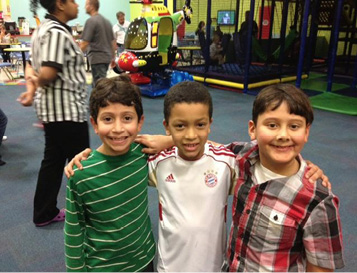
Three ethnically mixed seven-year-old boys: Hispanic-American, African-German, Indian-American.
Thinking in multiple dimensions will not only be an asset, but indispensable. Luckily, the ubiquitous nature of music and arts as an expressive form found in all cultures, allows for extensive exchanges of ideas from all corners of the globe.
Rationale for Teaching Multiculturally
Teaching Multiculturally Is…
Inclusive: It provides an opportunity for expression on behalf of many different groups that might otherwise not be represented.
- Consider the children in your classroom. If you have a heterogeneous class make up of many different ethnicities, abilities, races, providing activities validates who they are as people, and sends a message that their voices are valued. If you have a homogeneous class, exposing them to ideas and beliefs of others only helps to expand their worldview in a 21st century classroom.
Pedagogically Sound: Including multiple perspectives and views on material not only enriches the curriculum content, but also provides radically different frameworks and paradigms to students on content.
- For example we may be familiar with the concept of a “beat” from a Western perspective, but when exposed to the idea of a beat from Java’s gamelan music, we might develop a new appreciation of what a beat is, what it can do, and how it can be understood.
Teaching Multiculturally also…
Raises Awareness: Promotes awareness of self and others, fosters respect, tolerance and understanding.
Is Integrative: Provides excellent opportunities for integration as a natural entry or pivot point to other subject areas such as social studies, history, literature, language, and all of the arts.
Drawbacks
Most teachers, however, feel that they are not familiar enough with any material out of their comfort zone, and this is understandable. Also, there are time constraints, scheduling issues, materials and resources, and perhaps curricular or administrative support. Most teachers are also concerned regarding which cultures to include, and if they include too many, that they will be covering the content very superficially.
To be successful teaching multiculturally, it is important to:
- Familiarize yourself with the material/culture in advance.
- Teach indigenous concepts instead of Western ones.
- Use pedagogies that are indigenous or a close approximation to them.
II. Ethnomusicology and Music Teaching
To address some of the drawbacks and difficulties in teaching music from another culture, I’d like to turn to the field of ethnomusicology. The field of ethnomusicology is well positioned to contribute toward multicultural and diversity education, and, after a brief description of ethnomusicology, its tenets will be applied towards an examination of them. Recently, scholars such as Patricia Shehan Campbell, Therese Volk, and David Elliott have begun blending the disciplines of ethnomusicology and music education, bringing some of the field research and holistic view from ethnomusicology into the pedagogical practice of music education.
Ethnomusicology is the study of music as culture. Ethnomusicologists:
- Study all the world’s music.
- Study music within a total musical system, including songs, musical instruments and music production, as well as the people and culture that the music represents.
- Compare what is typical of a culture as well as what is personal, idiosyncratic, and exceptional.
Ethnomusicology, at its foundation, examines the relationship between music and culture. Ethnomusicologist Alan Merriam developed a “tripartite model” through which to understand the complex interactions between concept, behavior, and sound.
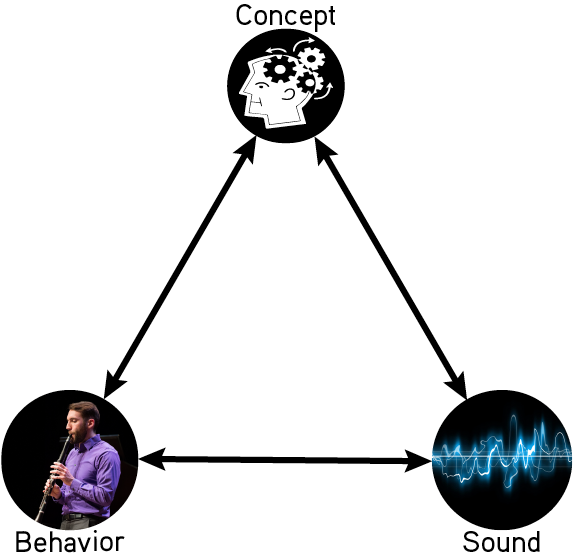
The Merriam Tripartite Model
Three components: Sound, Concept, and Behavior
We’ve discussed the idea of sound earlier in the book (i.e., timbre, melody, harmony, rhythm), and most of us can listen and recognize the elements of music to various degrees. We tend to think less, however, about the concepts or ideas that our culture has about sound and music. Ethnomusicologist Jeff Todd Titon states that we perform music in two ways. First, we perform the music itself (i.e., on instruments, by singing), and second, we perform the ideas associated with music. What does this mean? Growing up in a culture means that we have undergone a process called enculturation—meaning that we are familiar with the practices, rules, taboos, patterns, and beliefs about our culture’s ideas about music without having to actively learn them. If you look back at the brief quiz in the first chapter, you will find that you know things about music just having experienced and listened in your everyday life. As an ethnomusicologist or researcher for your classroom, however, it is important to be able to articulate the culture’s beliefs about music by observing people’s behavior and thoughts about music.
Activity 13A
Try this
One way to objectively view your own culture is to step back and imagine that you are an immigrant or an alien, perhaps, and are viewing the culture for the very first time. What might you observe about music in this culture? What do people believe about certain genres of music? Are certain types of music good? Harmful? What about musicians in general? Do we value them? Is it considered positive or negative to be a professional musician? When should certain types of music be played? When should you listen to certain types of music?
The third concept from Merriam’s model concerns our behavior as performers, audience members, listeners, etc. When do we perform music? How do we do it? What particular movements, gestures, and instruments do we use? Who performs? Who is allowed to perform certain music? Who is prohibited or “discouraged” from performing? Think about a type of music and its gender or racial makeup. Certainly, there are few genres of music that are performed equally across the board.
What this type of analysis does is to help us understand the cultural values associated with music, and what is important about sound and the concepts and behaviors associated with it. What is considered beautiful about a type of sound, instrument or voice? What a culture values, is an insight into that culture’s aesthetics. Let’s take a genre of music and find its cultural value and musical aesthetics. One example to consider might be opera. We might begin with a broad question as to whether opera is important and how it fits in with our culture.
Sound: In terms of opera’s musical aesthetics, (i.e. what is considered beautiful or pleasing), opera requires a well-trained, loud, and large voice with heavy vibrato. It takes years of practice to perfect this sound, uncountable hours of lessons, training, coaching. Singers, do not, for example, learn opera in their garages or simply by listening to recordings. Opera singers do not use microphones or any type of amplification technology. They are required to project their voice without assistance, which requires immense physical support. They sing arias, recitatives, choruses supported by an orchestra. The most popular repertoire they sing is mostly European, written in the 18th and 19th centuries.
Behavior: Singers on stage are expected to act in a certain way. They raise their arms in a gesture that amplifies our perception when singing high notes, they don’t jump around or dance when singing, smash their guitars on the ground, bite the heads off bats or set things on fire. Since opera is part of our Western Cultural heritage, there are institutions (conservatories, performance venues, etc.,) developed for those interested in this type of training and who have the requisite talent. Audiences who attend operas are usually able to afford the price of a ticket and are of an educational level and demographic cohort that supports, understands, and appreciates the form.
Concepts: As a genre, we believe opera to be a classical form, complicated, and with a long tradition and heritage rooted in the European classical tradition. Although we might not listen to it regularly or even at all, we all hold it in very high esteem, and an important part of a highly cultured society. Alternatively, we may not offer any national financial support.
Activity 13B
Try this
Think of a style or genre of music (i.e., classical, rap, rock, punk, heavy metal, country). Now go through the aesthetics of that genre according to Merriam’s Tripartite Model. What are the musical aesthetics of that music? What is culturally valued? Not valued?
III. Aesthetics and Multiculturalism
Our journey through Merriam’s model explores values and aesthetics, allows a deeper understanding of how to incorporate multicultural music into lessons. The process begins with discovering the musical aesthetics and particular values of the culture or sub-culture you’re working with. This might mean working with broad categories of Chinese, Indian or West African music, or narrow sub-cultures such as hip-hop music, Motown sound from the 1960s, or even the sound of an individual singer.
Regardless of what material you are trying to incorporate, thoroughly understanding the aesthetics and values will be highly beneficial to preserving the integrity and authenticity of both the music and culture. To do this requires preparation of research and practice.
Begin by selecting one culture area in which you are interested. Conduct research by reading about and exploring available teaching materials on that culture. Depending on your resources, you might want to actually acquire further knowledge and skills such as attending professional development activities or workshops, webinars, courses, or even contact people in your area that might be familiar with that culture. Starting with your own classroom is an excellent first step. There are always parents willing to come in and share traditions!
Teaching the music or arts of that culture is the next step. Fortunately, there are ways in which to use pedagogies that you already know in order to teach the material, without compromising its integrity or authenticity. The approach is to step back and ask questions to find commonalities in both cultures from which to work.
- How do children learn in this (new) culture (enculturation, pedagogies)?
- What musical aesthetics (sound) are found in this (new) culture’s music?
- What music does this (new) culture value (concepts, beliefs)?
- What behaviors are associated with this music?
Transmission
Most cultures around the world use aural-oral transmission process to teach many things, but especially music. Direct interaction with the sound is crucial, and notation cannot replace this experience. Children learn from each other by listening and joining in, learn by listening to recordings, or learn aurally from adults. In some cultures like India, even the classical music is transmitted aurally, with almost no notated music at all.
Aural transmission also enhances brain function since memorization is essential, along with mental mapping of melodies and rhythms. In the aural transmission process, modeling is a key factor. Since there is no restriction tying the singer to a “fixed” notation, children are free to just imitate or to explore, improvise and play with the sound.
Case Study 1: West Africa
For example, traditional music learning in West Africa takes place aurally. Let’s explore ways to utilize familiar pedagogies to approximate the core cultural values associated with music in West African culture. Note that the rhyme itself is not from West Africa, but it is the process of aural transmission itself that is one of the main goals of the lesson. This works well an opening lesson that 1) engages students using a familiar rhyme, 2) utilizes a culturally-based teaching process, and 3) transmits the cultural values of improvisation or “showing off,” musical play, communal music making, and musical flexibility, among other musical aesthetics.
Music pedagogy of West Africa compared to the U.S.
W. Africa |
U.S./Western |
|
Pedagogies |
|
|
Musical Aesthetics |
|
|
Values/Beliefs |
|
|
Behaviors |
|
|
While this list may be daunting, it is helpful in order to visualize the components necessary for a successful lesson—one that uses familiar pedagogies, materials, and processes between the two cultures. There is enough pedagogical overlap between the two to not only make a lesson work, but to contain a reasonable level of authenticity in its quest to successfully convey the intended musical and cultural material and values.
Revisit the pedagogies introduced in Chapter 4, Dalcroze, Kodály and Orff, to find excellent sources and approaches for teaching both Western and world musics. Dalcroze offers natural movement of the body, dance/movement and music; Kodály offers melodic and rhythmic sequencing; and Orff-Schulwerk offers a variety of aural singing and rhythmic body percussion techniques, including story-songs and literature, along with layers of percussion. This particular case study on West African music relies solely on aural learning, which means that a rote method is applicable to the music learning. In West Africa, rhythm is complex and highly valued, and involves communal/group participation, improvisation, and movement. West African music also integrates literature, movement, body percussion, rhyme, and music, so the Orff approach is probably the most applicable teaching method. Let’s take a simple playground rhyme as our material to teach West African musical and cultural values. (Note: This is but one variation of this particular rhyme.)
My mother, your mother live across the way.
Every night they have a fight and this is what they say:
‘Icka backa soda cracker, icka backa boo.
Icka backa soda cracker, out goes you!’
Rhythm: the rhyme is very simple with 8 beats in each line.
|
X |
X |
X |
X |
X |
X |
X |
X |
|
My |
mother |
your |
mother |
live a- |
cross the |
way |
(r) |
|
X |
X |
X |
X |
X |
X |
X |
X |
|
Every |
night they |
have a |
fight and |
this is |
what they |
say: |
(r) |
My Mother Your Mother
Learn the rhyme first using rote learning (call and response or echo). Then have the students clap on each beat. Repeat until the rhyme becomes embodied, and flows freely. Next, drop the “Icka Backa” section, and recite only the “my mother” section, while maintaining the steady beat clap throughout. Have everyone think the “Icka Backa” words in their head in order to remember the length of that section.
The rhyme itself implies that there is an inherent dialogue between the two mothers. This is perfect for implementing one of the essential elements of West African dance and music, where people take turns “showing their stuff” in a playfully confrontational way.
Form a circle. Communal learning lends itself to performing in a circle, and indeed most game songs are performed in a circle. Clap and say the rhyme several times. Choose two “mothers” to step out into the middle of the circle to face off against each other musically (no fighting or yelling)!
Each “mother” takes 8 beats to improvise using body percussion. Mother 1 “talks” for 8 beats, and Mother 2 then responds also taking 8 beats. Take turns around the circle alternating the rhyme with two new “mothers” in the center battling it out through rhythm, movement, and improvisation.
Improvisation
Improvisation, contrary to what many people think, does not involve “making it up on the spot.” Instead, improvisation can be taught to some degree in that it requires a set of tools and prior experiences from which to draw. Think of improvisation as “quickly assembling” shorter rhythm or pitch patterns that you’ve already mastered.
To prepare for the improvisation part of this rhyme, use rhythm cards for several weeks prior. Have the students clap the various rhythms using a variety of strategies, (call and response, game playing, even note reading, etc.) so that they are able to internalize the sounds and patterns. Then slowly build up from shorter 4-beat improvisations to 8-beat ones. This will reduce the anxiety of having to perform an 8-beat improvisation in front of the group.
Polyrhythm
Although improvisation is very important in many parts of Africa, so are complex rhythms called polyrhythms, which consist of two contrasting rhythms played together. The simplest and most basic polyrhythms are: two against three or three against four. To best illustrate a polyrhythm, the following system, known as the T.U.B.S. or Tiny Unit Box System, was developed as a way for participants to visualize the inner workings of a polyrhythm. Even though there are shaded areas that look like they represent musical “measures,” polyrhythms are referred to as additive rhythms (e.g. 2 + 3 + 2 + 3) rather than divisive (beats in a measure). Simple polyrhythms usually appear in eight or 12-beat groups.
Example 1: Two against Three
|
3-beat rhythm |
X |
X |
X |
X |
X |
X |
X |
X |
X |
X |
X |
X |
||||||||||||
|
2-beat rhythm |
X |
X |
X |
X |
X |
X |
X |
X |
Example 2: Three against Four
|
4-beat rhythm |
X |
X |
X |
X |
X |
X |
X |
X |
||||||||||||||||
|
3-beat rhythm |
X |
X |
X |
X |
X |
X |
Try clapping the above examples. For the Two against Three rhythm, divide the class into two groups and assign the Two-beat rhythm line to one half and the Three-beat rhythm line to the other half. Switch the groups. After everyone becomes comfortable with the rhythm, create smaller groups of people on each line, and eventually assign the rhythm to just two people. Some students may even be able to play a three-beat on one leg and a two-beat on the other. Then try the same process with the Four against Three rhythm.
Children’s clapping games and rock passing games provide very simple but accessible examples of polyrhythmic learning. Students can learn to feel, hear, and perform the multi-part music from a very early age, and become progressively more advanced as they grow.
Multi-modal complexity is very much part of many children’s game songs from Zimbabwe. The Zimbabwean game song “Sorida” contains a melody accompanied by body percussion and hand clapping in pairs of partners.
Sorida
Traditional Zimbabwe Children’s Song
Done with partners facing each other.
R L Clap indicates a paddy-cake style of clapping across to your partner.
Another example of a rock-passing game from Ghana in West Africa is “Obwisana.” In this game, all children sit closely in a circle, each with a small rock in front of them. Rock passing games such as “Obwisana” start out very simply, but the rocks can be tapped in more complex polyrhythms after the children master the easier rhythms. These games, like all children’s songs and games, carry great meaning. The lyrics mean “the rock crushed my hand, grandma,” and is meant to assure the child that there are always people to take care of them in their lives, either in their family or village. The rock-passing accompaniment reflects the idea of a tight-knit community and cooperation, for if even one child fails to pass their rock on the beat to the next child, the entire song cannot continue.
Obiswana
Children’s rock passing game from Ghana
Case Study 2: India
In comparison with African music, Indian music is much less familiar for most Westerners, and therefore a little more difficult to teach. The basic components of India’s classical music, for example, differ from Western music’s five basic elements (Sound, Melody, Harmony, Rhythm, and Form), in that India does not utilize harmony in its classical genres.
However, harmony is present in India’s popular music, such as Bollywood’s film music. Indian classical forms more than make up for an absence of harmony with highly complex and intricate melodies and rhythms.
Western Classical Music Aesthetics compared to Indian Classical Music Aesthetics.
Indian Classical Music Aesthetics |
Western Classical Music Aesthetics |
|
|
|
|
|
|
|
|
|
|
|
Classical Indian musical aesthetics require only three major components in an ensemble: a drone, a solo instrumentalist or vocalist, and a drum.
Listen Drone
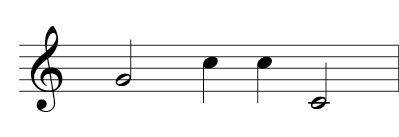
Melodies are based on raga, which is a set of pitches similar to what we think of as a scale, but with many more non-musical characteristics. Like a scale, a raga contains a certain set of pitches or notes. Some notes are flat, others sharp, etc. There is also often a mood associated with a raga, such as a time of day the song should be sung, or a season of the year like monsoon season, hot season, or winter. A raga might also be associated with a particular deity. The pitches of the scale have their own syllables called sargam—which is very similar to our solfege system. Just like the term solfege which is made up of the syllables “sol” and “fa,” sargam is comprised of the syllables sa re and ga, the first three pitches of the Indian scale.

Indian music has roots that are thousands of years old. There is cultural meaning in every aspect of Indian music. For example, each syllable of the sargam (solfege) is based on the sound of an animal.
Indian (Sargam) |
Western (Solfege) |
|
SA’ |
DO’ |
|
NI (elephant) |
TI |
|
DHA (horse) |
LA |
|
PA (cuckoo/nightingale) |
SOL |
|
MA (dove/heron) |
FA |
|
GA (goat) |
MI |
|
RE (bull/skylark) |
RE |
|
SA (peacock) |
DO |
Animals are very prevalent in India, particularly in the rural areas where you can hear the cries of peacocks, the whinnying of goats, and even the occasional cry of an elephant. These are familiar sounds to many children growing up in India.
Singers in training spent a lot of time learning to improvise with these syllables. Here are a few typical warm ups for the voice.
- SS, RR, GG, MM, PP, DD, NN, S’S’
- SRG, RGM, GMP, MPD, PDN, DNS’
- SRSRG, RGRGM, GMGMP, MPMPD, PDPDN, DNDNS’
- SRGSRGM, RGMRGMP, GMPGMPD, MPDMPDN, PDNPDNS’
In India, there really isn’t any notation at all since music is improvised, but in the 19th century, musicians developed a system for notation that is used to teach beginners. Here is an example of what that notation would look like for singing the song Frere Jacques. Dashes equal rests, and the slur underneath two notes is equal to two eighth notes.
C Major mode, 4/4 time, medium tempo
|
S R G S |
S R G S |
G M P – |
G M P – |
|
Fre-re Jac-ques |
Fre-re Jac-ques |
Dor-mez vous, |
Dor-mez vous? |
|
1 |
2 |
3 |
4 |
|
P_D P_M G S |
P_D P_M G S |
S P S – |
S P S – |
|
Son-nez les ma-ti-nes, |
Son-nez les ma-ti-nes, |
Din din don, |
Din din don |
|
1 |
2 |
3 |
4 |
Below is a song in one of the raga called Raga Bhupali. This raga is meant to be sung in the evening, and has a mood of devotion. It is a pentatonic raga, which means that only 5 pitches are used, Sa, Re, Ga, Pa and Dha.
Melody
Song in Raga Bhupali
|
S’ S’ D P |
G R S R |
||
|
G – P G |
D P G – |
G P D S’ |
R’ S’ D P |
|
S’ P D P |
G R S – |
S’ S’ D P |
G R S R |
|
G – P G |
D P G – |
Raga-s are made up of short characteristic patterns that often show up in compositions. The bold letters indicate patterns that are commonly found in many Bhupali songs.
Rhythm
Rhythm or tala in Indian music is very complex. Instead of having short measures of groups of 2s or 3s, there are long cycles of many beats.
Tala: A rhythmic cycle containing a fixed number of beats (e.g. 16, 14, 12, 10, 8, 7, or 6).
Indian musicians use the rhythm syllables of dha, dhin, etc. to learn rhythms on their drums (such as tabla). The second line of the table below indicates the vocal syllables for this particular 16-beat cycle. The third line of the cycle contains an X and numbers 2, 0, and 3, which are also guides to counting the cycle. Musicians say the rhythm syllables and then clap on the X, 2 and 3. The 0, however, is called an empty beat. On 0, the musician waves their hand instead of clapping. Try saying the rhythm syllables and clapping on the 1st, 5th, and 13th beats, and waving on the 9th beat of the cycle.
Tintal Rhythm Cycle (tala)
16-beat cycle, (4+4+4+4)
|
1 |
2 |
3 |
4 |
5 |
6 |
7 |
8 |
|
Dha |
Dhin |
Dhin |
Dha |
Dha |
Dhin |
Dhin |
Dha |
|
X |
2 |
|
9 |
10 |
11 |
12 |
13 |
14 |
15 |
16 |
|
Dha |
Tin |
Tin |
Ta |
Ta |
Dhin |
Dhin |
Dha |
|
0 |
3 |
X = Sam, the first beat and most important moment in music.
Activity 13C
Try This
The 16-beat tala teentala, is used in all of the above song examples, from Frere Jacques to the song in Raga Bhupali. Try singing the songs given above while clapping (on beats X, 2, and 3) and waving (on beat 0).
Children’s Music in India
Since many rural children in India do not have access to televisions, computers, or other electronic forms of entertainment, children play lots of games and learn many songs from each other in their local vernacular or regional language. Indian films, however, are all musicals, and contain five to six songs each. Children and even adults are exposed to and learn many, many of these popular film songs.
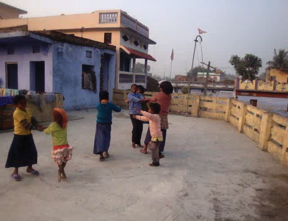
Children playing on a roof in a Bihar village, 2009.
Many parents restrict media viewing, for families with access, limiting the number of films they see as well as the hours spent watching television, listening to radio, and playing video games. Computer gaming and television watching is curtailed by these parents to one hour per day in exchange for study time.
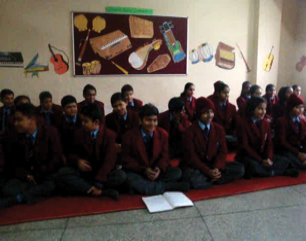
High School Music Class, New Delhi, India, 2009.
Below is a children’s game song called “Okaa Bokaa Teen Tarokaa” from Bihar, India. This rhyme and song is a good example of a children’s game song, which has many, many parts to it. The lyrics contain many references to animals, foods, perfumed oils, etc. There is also mention of a king and a princess, referring to a time when India was comprised of many feudal states ruled by kings.
Okaa, Bokaa
Children’s rhyme game from Bihar, India
Translation N. Sarrazin
Everyone is seated in a circle very close together for this game song. The actions for this rhyme are indicative of life and culture in India, and include motions that are both familiar and unfamiliar to children’s game songs in the U.S. For example, the beginning of the rhyme consists of an elimination game similar to “eenie, meenie, miney, mo” but pinching the back of the hand in the next section is rarely found in children’s game songs. Grabbing ones earlobes in India is a sign of contrition for one’s actions. It indicates that you are sorry and would like forgiveness.
Okā Bokā Tīn Tarokā
Children’s rhyme game from Bihar, India
Translation N. Sarrazin, A. Dwivedi
Hindi
Part 1
Okā bokā tīn tarokā
Lauā lāthī chandan kāthī
Chandanā ke nām kā
Ijayī bijayī
Panawā phūlelawa puchūk
Part 2
Chiuntā leba ki chiuntī
Part 3
Atkan chatkan dahī chatākan
Ban phūle banaila
Sawan mē karailā
Neuri gailī chorī
Dhar kān mamorī
Part 4 (chant)
Chiuntā ho chiuntā
Maamā ke gagariyā kāhe phora lā ho chiuntā
Part 5
Lātā lāti chal bariyāti
Part 6
Tār kāte tarkul kāte kāte re ban khājā
Hāthi upar ghanta bāje chamak chale re raja
Rājā ke dulari beti khub bajāwe bājā
Int māro jhint māro chhup
English
Part 1
Okā bokā tīn tarokā (three goats)
Twig and stick and sandalwood and
What is the name of sandalwood?
Victory, wictory
Betel leaf, perfumed oil, squeeze
Part 2
Will you be a small ant? Will you be a big ant?
Part 3
Pitter patter, splitter splatter
Wildflowers bloom in the jungle
Bitter gourds grow in the monsoon
Someone’s mongoose was stolen
Hold the ear and twist!
Part 4 (chant)
Ant, silly ant,
Why did you break uncle’s vase?
O ant, silly ant
Part 5
Kick and kick and then go to Baryaati
Part 6
Cut the palm tree, cut the palm grove, cut the palm fruit open
Atop the elephant the bell rings and the King arrives in splendor.
The lovely daughter of the King beautifully beats the drum.
Hit it, hit it, hit it, chop it off!
Game Directions
Part 1
Children sit in a circle and place both hands in front—palms down, fingertips touching the floor (like a spider). The leader taps the back of each hand to the beat. On the word “squeeze” (puchūk) the hand is flattened. Leader continues until all hands are flat.
Part 2
Leader pinches the back of each flattened hand and lifts them into a pile in the middle of the circle.
Part 3
Leader places hand on top of the pile and alternates slapping her hand palm up and palm down to the beat.
Part 4 (chant)
Each child grabs the earlobes of the child next to them in the circle and sways to the beat.
Part 5
Chaos! Children kick their feet rapidly in the middle of the circle touching soles with the others.
Part 6
Children create a tower of fists in the middle, with the thumb extended up, each child grabbing the upturned thumb of the child’s hand beneath. The leader makes a sawing motion to cut down this fist tower, “chopping” off a hand or two from the top when they say “hit it, chop it!”
Activity 13D
Try this
How does this game song compare to other game songs you are familiar with? Does it remind you of other games? What are some of the lyrics in the song that tell you about different cultural elements in India? Which movements are different from those found in Western children’s songs? Which are similar?
Case Study 3: Japan
Japanese Aesthetics
Japanese music can also be challenging, since its aesthetics are very different from those found in Western music. If we think back on the elements of Western music (sound, melody, rhythm, harmony, form), we see that almost all Western rhythm emphasizes a continuous, steady pulse or beat. Western music is very melodically and harmonically oriented, with a continuous rhythmic pulse. We need to grasp a melody and a drum beat or steady pulse in order to make sense of what we are hearing.
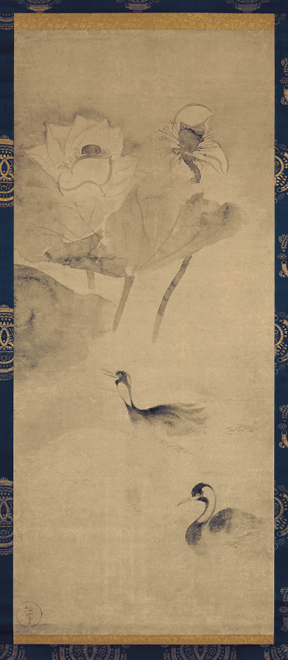
17th Century Japanese Painting, “Waterfowls in Lotus Pond”
In traditional Japanese music such as gagaku or shakuhachi however, a steady beat is non-existent, and the emphasis is overwhelmingly on timbre, which is part of sound. Stringed instruments such as the biwa are used sparingly to play a fixed harmony or chord that marks time rather than plays a melody, and the short sound patterns from an instrument such as a single small drum or gong, might be front and center. How are we supposed to listen to this music? Japanese music relies on subtle changes and exploration of timbre rather than continuous sound. It takes a great deal of listening and understanding to be able to listen to and appreciate this music.
In Japan, key cultural, musical and artistic aesthetics include:
- Ritual
- Process over product
- Nature
- Reference to, reproducing, or connecting with (i.e. Shakuhachi made of bamboo)
- Simplicity
- Minimal sound, maximum effect
- Space/silence
- Form and the destruction of form
- Idea of impermanence
- Variation
- Multiple perspectives
Traditional Japanese art such as that pictured above, uses the same aesthetics. Notice all of the white space in the painting, and its minimalist nature. In the music, this white space is represented by silence. The same goes for Japanese flower arranging ikebana, where a single flower in a simple vase succinctly expresses the nature of Japanese aesthetics and worldview.
Japanese musical aesthetics are difficult to apply in the classroom. The first thing that children will want to do is play a steady beat on the drum and create a melody. This is so ingrained, that it is almost impossible to unlearn this Western cultural norm.
Classroom equivalents of traditional Japanese instruments.
Category |
Traditional Japanese Instruments |
Classroom Equivalent |
|
Wind |
Hichiriki (type of oboe) Ryūteki (transverse flute) Shō (mouth organ) Shakuhachi (bamboo flute) |
Duck call Recorder Harmonica Pan pipe |
|
String |
Biwa (4 stringed lute) Koto (13 stringed zither) |
Guitar Autoharp |
|
Percussion |
Shoko (small gong struck with 2 horn beaters) Kakko (small, hourglass-shaped drum struck with 2 wooden sticks) Tsuri-daiko (drum on a stand with painted head played with padded stick) Shakubyoski (clapper made from pair of flat wooden sticks) |
Gong Hand drum Djembe Woodblock |
However, approaching Japanese music from the perspective of timbre and silence, and to use visuals such as the classical paintings above to represent the simplicity of the music can help.
- Begin by passing out various percussion instruments, and even pitched instruments such as an autoharp, glockenspiel, or xylophone.
- Have students create as many different timbres as possible on their instrument, and as many “cool sounds” as possible. Remember, the autoharp should just play one chord with a lot of space in between strumming.
- Practice simple rhythmic patterns (ti-ti-ta, ta ta, ti-ti ti-ti) on the instruments.

- Hitting the small drum or gong, for example, is not a matter of creating a steady beat, but of bringing subtle changes in timbre to the composition. This concept can be taught using an object like a bouncy ball. Take a bouncy ball, and drop it on the floor once. At first, it hits with a loud thwack. Each successive bounce, becomes both fainter and faster. Imitating this sound on a small gong or drumhead will approximate the type of play with timbre that is required.
- Then work to put the group together. Remember, only one or two sounds should be played at a time, with a lots of silence in between, no harmony or melody or steady pulse should emerge. Silence, called ma, is very important in Japanese music. If you look at the classical nature painting above, you will see a lot of “white space.” This white space in art is equivalent to silence in music.
- Instruments should be played slowly, thoughtfully, and deliberately, not rushed and with a lot of stylized movement (dramatic but slow sweeps of the arm, positioning of drumsticks or mallets far in advance of striking, attentive and very alert and still musicians when not playing).
After some practice with this, it will be easy to plan an integrated multicultural lesson using something like kamishibai, or Japanese story cards. Having children play Orff instruments and classroom instruments as sound effects using the aesthetics above, would add greatly to the stories, as would composing an original song for the stories.
Japanese Kamishaibai (Japanese Story Cards)
The information below comes from an MENC article and interview with Dorothy Kittaka about Kamishibai, the multicultural, literacy-oriented Japanese story cards. The material introduces Japan to children, and provide a lesson rich in culture, literacy, and music. Click here for Kittaka’s complete lesson plan.
“Kamishibai is a delightful way of introducing literature, culture, and the arts” to children, says MENC member Dorothy Kittaka. This traditional Japanese form of storytelling will draw students in while they make connections with music, the visual arts, language arts, history, culture, and character education.
What is Kamishibai?
Kamishibai (“paper theatre”) is picture storytelling that uses painted cards to illustrate a story that’s written on the back of the cards. The traditional stories teach life lessons and emphasize traits such as:
- Integrity
- Caring
- Common Sense
- Initiative
- Perseverance
- Organization
- Flexibility
- Problem Solving
- Responsibility
- Cooperation
- Patience
- Friendship
- Curiosity
- Courage
- Resourcefulness
- Sense of humor
Original Kamishibai stories are written in dialog form, so the storyteller becomes an animated actor voicing different characters, making a compelling drama.
How to use Kamishibai:
- Select a story and read it to the class using the story cards. (For example, the “One Inch Boy” teaches that no matter what size you are, you can still achieve and be brave and honorable. Good for grades K–2.)
- Have students use percussion instruments, tuned xylophones, and body percussion to add sound effects as you read the story again with the story cards.
- Have students compose songs to go with the Kamishibai story as a class, in groups, or individually.
- Have students create poems and haiku as a class to reflect the story line. This works with even very young children.
- Tell the story again with story cards and musical accompaniment. Record it for listening and critiquing.
- Older grades can write their own stories, illustrate them, and compose songs for them.
For more information and lesson plans on Kamishibai by Dorothy Kittaka, go to http://www.kamishibai.com/index.html
Multicultural Music: Finding Sources, Making Plans
“Part of my teaching philosophy is to introduce students to other cultures and help them discover a bigger world,” says MENC member Linda White.
In searching out sources of multicultural music, White suggests:
- Read books about other cultures (not just music-related books).
- Attend concerts with musicians and music from other places.
- Take classes that teach music and games from other countries.
- Invite parents or others in the community from other countries to school—for classroom visits or assemblies.
- Attend sessions on multicultural music at MENC, Orff, and Kodály conferences, and consult with the clinicians.
Recommended Resources
- MENC and Orff magazine articles
- Japanese Kamishibai (a form of storytelling)–great for introducing Japanese stories and incorporating Japanese songs. (See Kamishibai Story Theater)
- Mary Goetze and Jay Fern’s Global Voices in Song DVDs–full of dances, songs, games, and background about various cultures.
Evaluating Multicultural Teaching Material
As a professional working with children, you will be constantly searching for new material to bring to your students such as songs, games, activities, lesson plans, etc. But how do you judge these materials? What is their value? In terms of musical material, it is important to assess the sonic aspects as well as the written. Is there a download or recording involved? What is the quality of that recording? What is the content included? How relevant or valuable is that content?
In terms of any teaching material, it is important to look and listen for quality content. However, if we are not familiar with the culture from which the recordings or material came, our job is more difficult. How do you assess an unfamiliar sound? Below is a rubric for evaluating multicultural music material including the content of the text, notation, and any recording.
Multicultural Material Evaluation Rubric
Summary |
Describe the book’s content. What is included? What is its presentation? Layout? Format? Sections? |
Provides a general overview of the book itself. |
Author |
What evidence do you see in the book of their experience and knowledge? |
While it might seem like someone from the culture itself might have a more “authentic” perspective, this does not necessarily mean they do. Look for time spent researching in the culture, teaching, advanced degrees, field specialty (i.e., ethnomusicologist). |
|
Is there a secondary author? What is their role? |
Many times the primary author does not have enough insider knowledge of the language, and has to rely on someone with that knowledge to help with song lyrics and other cultural attributes. |
|
Notation |
Does the book contain printed notation? If so, what type of notation is used? |
Mostly, books used in the U.S. will use standard 5-line staff notation. However, many cultures have their own forms of notation such India, Indonesia, and China, etc. Are any of these types of notation used in the text? |
|
Are the songs arranged in any way? |
A song arrangement typically means adding voices such as making a choral arrangement or adding instruments to the melody such as a piano accompaniment or Orff accompaniment. |
|
|
Is the arrangement typical for the culture or not? Do they include any indigenous instruments? |
Many cultures have their own styles of arrangement, but adding piano chords or vocal harmony particularly for Asian music, is not typical. |
|
Lyrics |
Do the songs have lyrics in English? The original language? Both? Is a pronunciation guide included? Are the meanings of specific words explained? |
Often, books will include a transliteration of how to pronounce the lyrics as well as a translation. Some will even write the lyrics in the script of the original language. |
Movement/Dance |
Are dance, game, or movement instructions included? If so, are they clearly written with photographs, diagrams, and illustrations? Are the movements indigenous or Westernized? |
Similarly, you would prefer if the movements included along with the song were indigenous to the song itself and not merely added on as movement unassociated with the culture. |
|
Do any of the movements have symbolic or cultural meaning? Which? |
||
Recordings |
Are there recordings included with the book? (tape, CD or online downloads or mp3s)? Who recorded the songs and who is singing on the recordings? (i.e., people from within the culture or outside? children, adults?) Which instruments or arrangements are used (i.e., is it only synthesizer or piano or are authentic instruments used? Is harmony added?) |
The most authentic recordings are those made in the field itself, of course, but it is also informative to have singers from that culture in the studio creating a professional recording. In some older recordings, the singing would be re-recorded by a Western chorus, which took away from the experience of hearing the song. Also, to save money, a synthesizer would be used to accompany the recordings rather than authentic instruments. |
Context |
How much written cultural context is included in the book in general or for each song? |
Books vary widely on their inclusion of cultural information, but some type of description adds tremendously to the value of the book and to the understanding required to evaluate and learn the material. |
|
How much of the original song’s function and meaning is included? |
Knowing the original function of the song is an additional way of digging deeper into the culture. Knowing how a song works in the lives of children is greatly beneficial. |
|
|
Do the notes offer a description of the culture, values, customs, historical, geographic, and economic issues that may add to an understanding of the music? |
Having even some general details including maps, pictures, photos, quotes, and individual stories, and historical information helps. |
|
Conclusion |
Would you recommend/use this book, why or why not? |
After reflecting on all aspects of your evaluation, would you use this book in your classroom or recommend it to others to use, why or why not? |
References
Adzenyah, A., Maraire, D., & Tucker, J. (1996). Let your voice be heard! Songs from Ghana and Zimbabwe. Danbury, CT: World Music Press.
Boyer-Alexander, R. (2002). Celebrating African-American history through plantation songs and folklore. Milwaukee, WI: Hal Leonard.
Brumfield, S. (2006). Hot peas and barley-o: Children’s songs and games from Scotland. Milwaukee, WI: Hal Leonard.
Buenker, J., & Ratner, L. (2005). Multiculturalism in the United States: A comparative guide to acculturation and ethnicity. Westport, CT: Greenwood Press.
Campbell, P., McCullough-Brabson, E., & Tucker, J. (1994). Roots and branches: A legacy of multicultural music for children. Danbury, CT: World Music Press.
Campbell, P., & Frega, A. (2001). Songs of Latin America: From the field to the classroom. Van Nuys, CA: Alfred Music.
Elliott, D. (1995). Music matters: A new philosophy of music education. Oxford: Oxford University Press.
Gold, M., Grant, C., and Rivlin, H. N. (Eds.). (1977). In praise of diversity: A resource book for multicultural education. Washington, DC: Teacher Corps. Retrieved from http://books.google.com/books/about/In_Praise_of_Diversity.html?id=5LU0AAAAMAAJ
Kiester, G. (2005). India: Games children sing: 16 children’s songs and rhymes. Van Nuys, CA: Alfred Publishers.
Knapp, D. (2011). The inclusive world of music: Students with disabilities and multiculturalism. General Music Today, 25(1), 41-44.
National Association for Music Education. (2009). Kamishibai: Emotional hook for learning. Retrieved from http://nafme.org/kamishibai-emotional-hook-for-learning/
Sarrazin, N. (2008). Indian music for the classroom. Lanham, MD: MENC, Rowman and Littlefield.
Sarrazin, N. (2006). India’s music: Popular film songs in the classroom. Music Educators Journal 93(1), 26–32.
Sarrazin, N. (2006). Multicultural music in the classroom: Teaching burden or good musicianship? Asia Pacific Journal of Arts Education 3 (2).
Sarrazin, N. (1995). Exploring aesthetics: Focus on Native Americans. Music Educators Journal 4, 33–36.
Volk, T. (2004). Music, education and multiculturalism: Foundations and principles. Oxford: Oxford University Press.
India Resources
References
- The Raga guide: Survey of 74 Hindustani raga-s [CD]. (1999). Ganarew, England: Nimbus Records.
- Kiester, G. (2006). Games children sing—India. Van Nuys, CA: Alfred Publishing.
- Sarrazin, N. (2006). India’s music: Popular film songs in the classroom. Music Educators Journal, 93(1), 26–32.
- Sarrazin, N. (2008). Indian music for the classroom. Lanham, MD: MENC, and Rowman Littlefield.
Children’s Literature
- Arnett, R., & Turakhia, S. (2003). Finder’s keepers. Columbus, GA: Atman Press.
- Somaiah, R., & Somaiah, R. (2006). Indian children’s favourite stories. Rutland, VT: Tuttle Publishing.
Internet
- The Music of India. David Courtney’s encyclopedic website. Everything from classical to film to folk. Excellent resource: www.chandrakantha.com
- Music India Online. Many musical genres (classical, folk, film)! mio.to/#/
- Downloadable: Tanpura Drones. http://www.ocf.berkeley.edu/~mrahaim/
- Kennedy Center ArtsEdge’s “The Music of India: An Exploration of Indian Music”. https://www.kennedy-center.org/education/resources-for-educators/classroom-resources/media-and-interactives/media/international/music-of-india/
- Introducing India. https://www.pbs.org/thestoryofindia/teachers/lessons/
Vocabulary
acculturate: learning a new language, giving up traditional customs, heritage, etc., in order to blend, melt, and assimilate
assimilation: explains the process of cultural and psychological change that results following meeting between cultures. The effects of acculturation can be seen at multiple levels in both interacting cultures. At the group level, acculturation often results in changes to culture, customs, food, clothing, language, and social institutions. At the individual level, differences in the way individuals acculturate have been shown to be associated not just with changes in daily behavior, but with numerous measures of psychological and physical well-being. Acculturation can be thought of as second-culture learning
authenticity: how closely a performance of a piece of music conforms to the author’s intention; how closely a work of art conforms to an artistic tradition; how much the work possesses original or inherent authority, how much sincerity, genuineness of expression, and moral passion the artist or performer puts into the work
behavior: how we act as performers, audience members, listeners, etc.
cultural assimilation: the process by which a subaltern group’s native language and culture are lost under pressure to assimilate to those of a dominant cultural group
cultural mosaic: refers to the mix of languages, cultures, and ethnic groups that co-exist in society; intended to champion an ideal of multiculturalism as opposed to other systems like the melting pot, which is often used to describe the U.S.’ supposed ideal of assimilation
cultural pluralism: when smaller groups within a larger society maintain their unique cultural identities, and their values and practices are accepted by the wider culture provided they are consistent with the laws and values of the wider society
enculturation: the process whereby the established culture teaches an individual the accepted norms and values of the culture or society where the individual lives; learning your first culture
ethnicity: a socially defined category based on common culture or nationality; can include a common ancestry, dress, religion, dialect, etc.; reinforced through common characteristics, which set the group apart from other groups
homogeneous: the same or similar in nature
melting pot: metaphor for a heterogeneous society becoming more homogeneous, the different elements “melting together” into a harmonious whole with a common culture. It is particularly used to describe the assimilation of immigrants to the U.S. the melting-together metaphor was in use by the 1780s
multiculturalism: the action, process, or practice of including several cultures
multiethnic society: one with members belonging to more than one ethnic group, in contrast to societies that are ethnically homogeneous
musical aesthetics: what is considered beautiful or pleasing to listeners as a result of the music
polyrhythm: two or more contrasting rhythms such as groups of two played against groups of three
subaltern: lower in position or rank, a secondary group. Often this means a lack of access to political and financial power
Western culture: a heritage of social norms, ethical values, traditional customs, belief systems, specific artifacts, and technologies that have some origin or association with Europe; applies to countries whose history is strongly marked by European immigration, such as the Americas and Australasia as well as Europe








